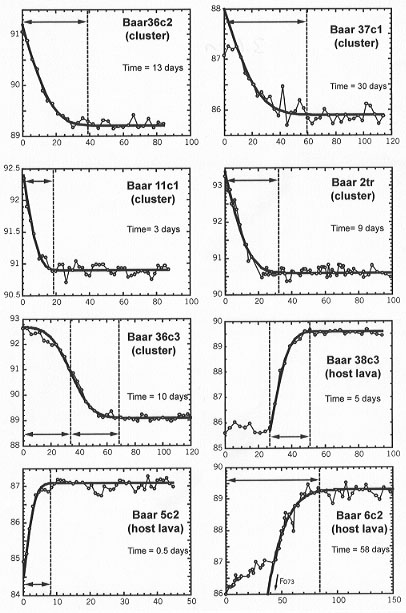

Knowledge of the origin of silicate glass inclusions in mantle xenoliths is important to our understanding of the evolution of the Earth's upper mantle and the textural and chemical changes that affect mantle xenoliths as they are carried to the Earth's surface. There is a great deal of controversy over the origin of these inclusions. Many workers have suggested that they are low percentage, in-situ partial melts or the quenched remains of melts responsible for mantle metasomatism. However, recent experimental studies (Annual Report 1997, 1998) show that many of these glasses can be formed during xenolith transport and thus are not linked to in-situ partial melting or mantle metasomatism.
Given that there are at least nine different mechanisms by which melt may form in mantle xenoliths, it is likely that no single process can account for the formation of all the glass in a single suite of samples. To test this hypothesis we have examined a suite of glass-bearing mantle xenoliths from a new locality in the Quaternary West Eifel volcanic field of Germany. We have identified five distinct petrographic and compositional varieties of glass (Fig. 3.6-1):
1) Evolved, silica-undersaturated alkaline glass that forms rims and veins around and within the xenoliths;
2) Silica - saturated alkaline glass in Cr-diopside + olivine + spinel clusters associated with amphibole in harzburgites and wehrlites;
3) Silica-undersaturated glass associated with rhönite in partly to completely broken-down amphibole grains in clinopyroxenites;
4) Silica-undersaturated, potassic glass associated with phlogopite in peridotite and glimmerite xenoliths;
5) Very silica-rich glass around partly dissolved orthopyroxene crystals.
Based on texture, composition and calculated P-T conditions we have determined the following sequence of glass formation in these xenoliths:
1) High-pressure, high-temperature breakdown of amphibole in harzburgite xenoliths over the range 1.4 to 1.1 GPa and ˜1250°C. This event was probably related to the initial entrainment of the xenoliths.
 |
Fig. 3.6-1: Variation in forsterite content of olivine adjacent to the Cr-diopside - olivine - spinel - glass clusters and host lava. Distances are in microns; the zero point represents the contact between the olivine crystal and glass. The thick line is the result of numerical calculations of diffusion. The arrows represent the profile length used in diffusion time calculations. Times were calculated using D= 8.6 * 10-17 m2s-1. |
2) Breakdown of amphibole in wehrlite xenoliths. This event occurred at lower pressures, from 0.9 to 0.6 GPa and at temperatures from 1125 to 1200°C, suggesting that the wehrlite xenoliths were entrained at a higher level in the mantle. Diffusion profiles in xenolith olivine adjacent to the amphibole breakdown regions indicate that olivine and melt were in contact for times ranging from 9 to 30 days.
3) Entrainment of amphibole-bearing clinopyroxenite xenoliths from the uppermost mantle. Amphibole in these xenoliths shows clear evidence for breakdown. However, the presence of rhönite as part of the microlite assemblage suggests that this breakdown occurred at relatively low (crustal) pressure.
4) Partial crystallisation of the host magma during ascent. Fractionated residual melt from the host collected around the xenoliths and penetrated fractures where it reacted with phlogopite, orthopyroxene and mixed with the melt formed by amphibole breakdown. Modeling of the time taken for development of diffusion profiles at olivine - host contact indicates contact times between 0.5 and 58 days. The s-shaped diffusion profiles in several samples are best explained by an increase in mg# during the diffusion process. This likely reflects magma mixing early in the entrainment history of the xenoliths.
Our results suggest that all of the glass in these xenoliths formed over a short time by a variety of processes. None of the glass in these xenoliths is related to metasomatism or any other process that occurred in-situ in the mantle. Rather it formed as a result of processes related to the transport of the xenoliths to the Earth's surface.

Tel: +49-(0) 921 55 3700 / 3766, Fax: +49-(0) 921 55 3769, E-mail: bayerisches.geoinstitut(at)uni-bayreuth.de
 Previous page
Previous page